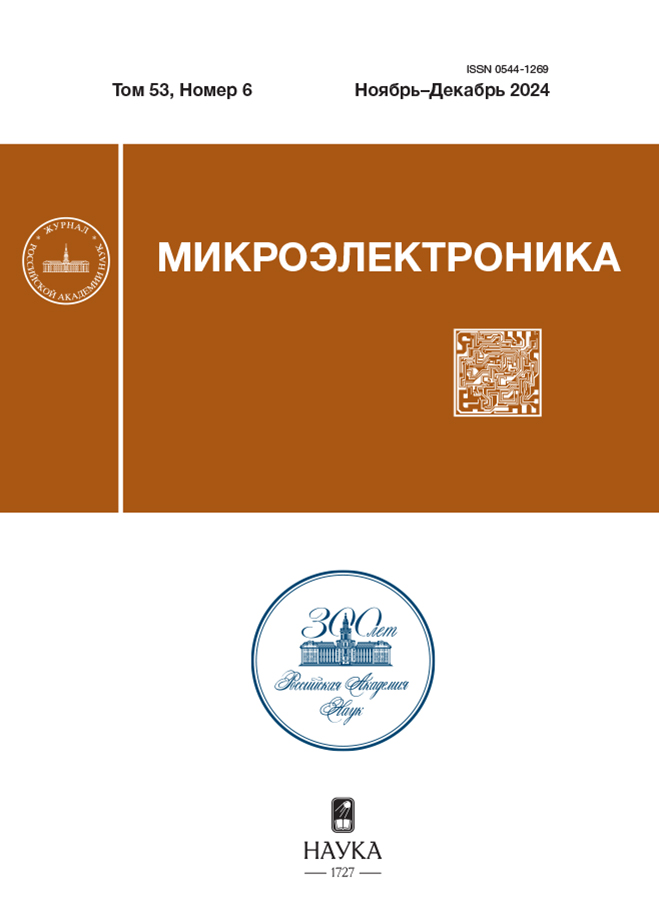Conductivity Study of Carbon Nanotubes Deposited on Iridium Silicon-Silicide Substrate
- Autores: Kerimov E.A.1
-
Afiliações:
- Azerbaijan Technical University
- Edição: Volume 53, Nº 6 (2024)
- Páginas: 570-576
- Seção: TECHNOLOGIES
- URL: https://rjonco.com/0544-1269/article/view/681476
- DOI: https://doi.org/10.31857/S0544126924060095
- ID: 681476
Citar
Texto integral
Resumo
Realization of any elements at the nanometer level at this stage of nanoelectronics development is possible only under the condition of integration with industrial microelectronics technology. The limiting factor becomes the realization of the interface of two levels of technology: nano and micro. The crisis of metallic interconnects entering a new phase, associated with increasing delays in wiring, levels the merits of nanostructures possessing ballistic conduction mechanism [1–4]. Nanotubes possess metallic or semiconductor type conductivity depending on the chirality angle in diameter. Accordingly, the former can fulfill the role of ideal contacts to devices based on molecular or tunnel structures or radiation sources, while the latter claim to be active elements of nanoelectronics rectifying diodes, transistors, chemical and biological sensors.
Palavras-chave
Texto integral
Sobre autores
E. Kerimov
Azerbaijan Technical University
Autor responsável pela correspondência
Email: E_Kerimov.fizik@mail.ru
Azerbaijão, Baku
Bibliografia
- Znidarsic A. et al. Spatially Resolved Transport Properties of Pristine and Doped Single-Walled Carbon Nanotube Networks // J. Phys. Chem. c. 2013, v. 117, 13324–13330 p.
- Bhattacharya A.R., Sreekumar T.V., Liu T., Kumar S., Erickson L.M., Hauge R.H., et al. Crystallization and orientation studies of polypropylene/single-walled carbon nanotube composites. Polymer 2003; 44: 2373–7.
- Yu M.-F. et al. Strength and Breaking Mechanism of Multiwalled Carbon Nanotubes Under Tensile Load // Science (80). 2000. Vol. 287, № 5453, 637 LP, 640 p.
- White C. M., Banks R., Hamerton I., & Watts J. F. (2016). Characterisation of commercially CVD grown multi-walled carbon nanotubes for paint applications. Progress in Organic Coatings, 90, 2015.09.020, 44–53 p.
- Lee J., Lee S., Bae G., et al. Exposure assessment of carbon nanotube manufacturing workplaces. Inhal Toxicol. 2010; 22(5): 369–381.
- Bello D., Wardle B., Yamamoto N., et al. Exposure to nanoscale particles and fibers during machining of hybrid advanced composites containing carbon nanotubes. J Nanopart Res. 2009; 11(1): 231–249.
- Ellenbecker M., Tsai S. Chapter 11: The regulatory environment for engineered nanoparticles. In: Health and Safety Considerations for Working with Engineered Nanoparticles in Industry. Wiley, in press, 2014.
- van Broekhuizen P., van Broekhuizen F., Cornelissen R., et al. Workplace exposure to nanoparticles and the application of provisional nanoference values in times of uncertain risks. J Nanopart Res. 2012; 14: 70.
- Khodakovskaya M., Dervishi E., Mahmood M., et al. Carbon nanotubes are able to penetrate plant seed coat and dramatically affect seed germination and plant growth. ACS Nano. 2009; 3(10): 3221–3227.
- Khodakovskaya M., de Silva K., Nedosekin D., et al. Complex genetic, photothermal, and photoacoustic analysis of nanoparticle-plant interactions. Proc Natl Acad Sci USA. 2011; 108(3): 1028–1033.
- Tripathi S., Sonkar S., Sarkar S. Growth stimulation of gram (Cicer arietinum) plant by water soluble carbon nanotubes. Nanoscale. 2011; 3(3): 1176–1181.
- Hansen S., Maynard S., Baun A., et al. Late lessons from early warnings for nanotechnology. Nat Nanotechnol. 2008; 3: 444–447.
- Jackson P., Jacobsen N., Baun A., et al. Bioaccumulation and ecotoxicity of carbon nanotubes. Chem Cent J. 2013; 13(7): 154.
- Petersen E., Zhang L., Mattison N., et al. Potential release pathways, environmental fate, and ecological risks of carbon nanotubes. Env Sci Technol. 2011; 45(23): 9837–9856.
- Kagan V., Tyurina Y., Tyurin V., et al. Direct and indirect effects of single walled carbon nanotubes on RAW 264.7 macrophages: role of iron. Toxicol Lett. 2006; 165: 88–100.
- Muller J., Delos M., Panin N., et al. Absence of carcinogenic response to multiwall carbon nanotubes in a 2-year bioassay in the peritoneal cavity of the rat. Toxicol Sci. 2009; 110: 442–448.
Arquivos suplementares













